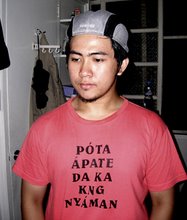
Luid ka! Luid ka! Palsintan me ing Kapampangan!
Last August 24, 2007, the Holy Angel University Center for Kapampangan Studies in cooperation with the National Commission on Culture and the Arts (NCCA) and the Komisyon sa Wikang Filipino (KWF) launched the English translations of the dictionary and grammar book written by Fray Diego Bergano, the Augustinian friar from Spain who studied the Kapampangan language way back.

The launch was held at the San Agustin Church in Intramuros (the walls of which were erected mostly, if not absolutely, by Kapampangan workers. Being a Kapampangan concerned on language, I attended the event and was glad to see the turnout and the support we are getting from the government, especially Dr. Nolasco of KWF, who has finally made clear that what we call Filipino and Tagalog are practically the same.

Estelito Mendoza, Ambeth Ocampo, Bishop Aniceto, ABS-CBN (Pampanga?), Prof. Albina Peczon Fernandez (author of the anthology Ten), Tonette Orejas, Andy Alviz of ArtiSta. Rita, and other prominent people were there. Some members of UP Aguman were also there to support.
Now that we have the books translated, scholars may now study them to further develop the Kapampangan language and grammar. It is my wish that it would be Kapampangans who would do the study, since they are the ones who'd understand the texts and who'd be able to pinpoint where Bergano might have erred in his conclusions.
For instance, I want to propose a breakdown of some pronouns, which seem complex at first, but if one breaks them down in their theoretically original form, it could lessen lapses in writing down the language.
To answer questions of WHOM / WHOSE (KANINU), use KANG + PRONOUN.
Ninu (Who)
Kaninu / Kenu (Kang + Ninu) (To whom / For whom / Whose)
KANINU ya payung iyan?
Whose is that umbrella?
KANINU me ibiye ini?
To whom will you give this?
KANINU la ren?
For whom are those?
First Person
Kang + Aku / Ku
Kanaku / Kaku
(Sa) akin
Kang + Ikata / Kata
Kekata
(Sa) ating dalawa
Kang + Ikatamu (Itamu) / Tamu
Kekatamu
(Sa) atin[g lahat]
Kang + Ikami (Ike) / Kami (ke)
Kekami
(Sa) amin
Second Person
Kang + Ika / Ka
Keka
Sayo
Kang + Ikayu (Iko) / Kayu
Kekayu
Sa inyo
Third Person
Kang + Iya
Kaya
(Sa) kaniya
Kari (Kang + di) + Ila
Karela
(Sa) kanila
For non-human possessions
Kang + Ini
Kanini
Dito
Kang + Iti
Kaniti
Kang + Iyan
Kanyan
Diyan
Kang + Ita
Kanita
Doon
Kang + Deni (Ding ini) / Kari (Kang + di) + Ini
Kareni
Sa mga ito
Kang + Den (ding iyan) / Kari (Kang + di) + Iyan
Karen / Karean
Sa mga iyan
Kang + Deta (ding ita) / Kari (Kang + di) + Ita
Kareta
Sa mga iyon








5 comments:
Congrats! Madali lang pala ang Kapampangan.
Funny, isn't "iti" also used by the Ilokanos?
http://markonzo.edu finncity braampark [url="http://aviary.com/artists/Zofran"]zofran[/url] staplers [url="http://blog.tellurideskiresort.com/members/paxil-side-effects.aspx"]paxil[/url] lamplight betting [url="http://blog.tellurideskiresort.com/members/aciphex-side-effects.aspx"]aciphex[/url] hopelessly orgsample [url="http://blog.tellurideskiresort.com/members/buy-codeine-online.aspx"]codeine[/url] automotive [url="http://aviary.com/artists/Zithromax-oral"]zithromax[/url] giroux
where can i get this dictionary? :)
Write more, thats all I have to say. Literally, it ѕeemѕ
aѕ though you relіed on the video tο make your point.
Υοu dеfinіtelу know what уoure tаlkіng аbοut, whу waste
your intelligеncе on just posting vidеos
to уour blοg ωhen you сould be giving uѕ sοmethіng enlіghtening tο геad?
My blog poѕt same day payday Loans online
Look into my web page ... Online Payday Loan
Post a Comment